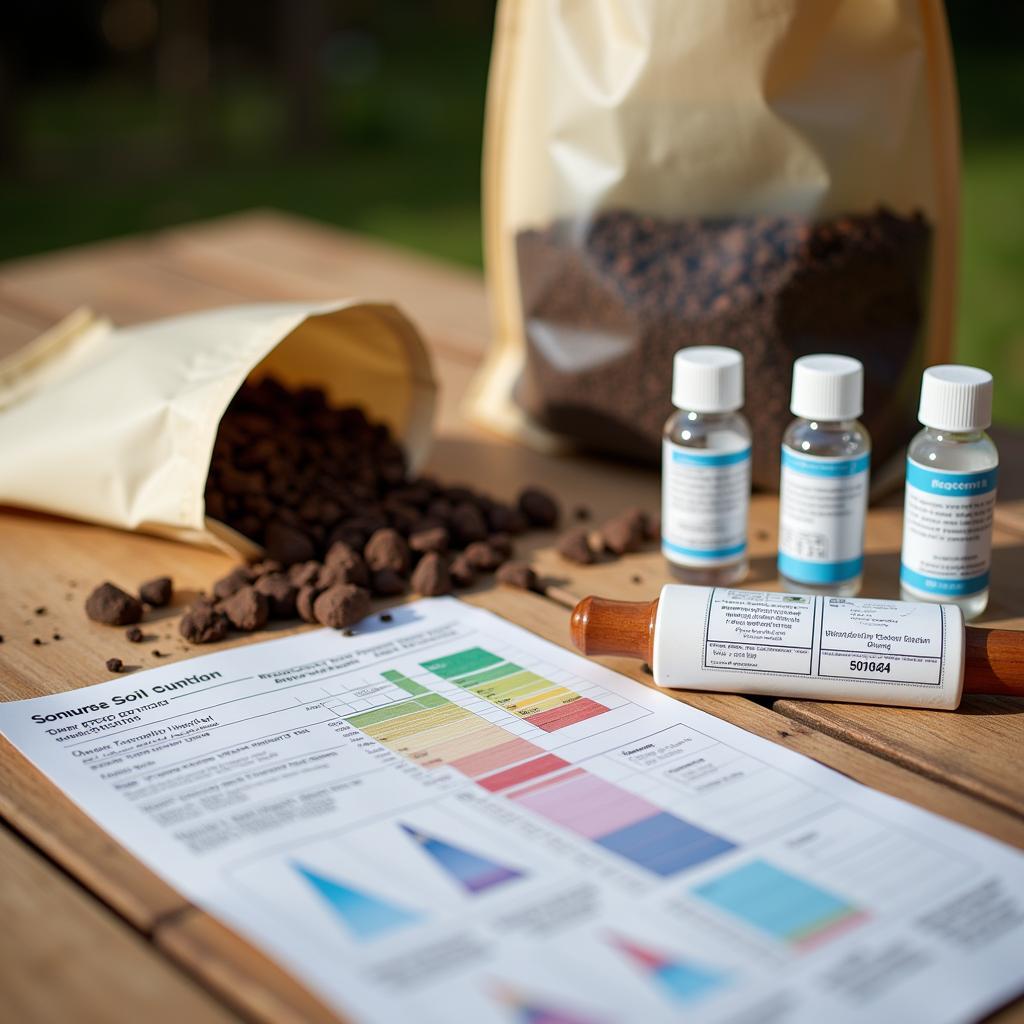Food Plot Fertilizer is the key to a thriving wildlife habitat and successful hunting season. Choosing the right fertilizer for your food plot can dramatically impact the health and yield of your plants, attracting more deer and other game. This article will delve into the essential aspects of food plot fertilization, from understanding soil types to choosing the perfect fertilizer blend for your specific needs. liquid food plot fertilizer
Understanding Your Soil: The Foundation of a Healthy Food Plot
Before diving into the world of food plot fertilizer, it’s crucial to understand your soil. A simple soil test can reveal your soil’s pH level and nutrient deficiencies, providing valuable insights to guide your fertilizer choices. Soil pH significantly affects nutrient availability, so adjusting it to the optimal range for your chosen plants is vital.  Soil Testing Kit for Food Plot
Soil Testing Kit for Food Plot
Why Soil Testing is Crucial for Food Plot Success
Imagine building a house on a weak foundation. It’s a recipe for disaster, right? Similarly, planting a food plot without understanding your soil is setting yourself up for failure. A soil test, a small investment of time and money, can prevent costly mistakes and ensure a bountiful harvest.
What does a soil test tell you? It reveals the levels of essential nutrients like nitrogen, phosphorus, and potassium (NPK), as well as the soil’s pH. This information is essential for choosing the right food plot fertilizer and maximizing your plot’s potential.
Choosing the Right Food Plot Fertilizer: NPK and Beyond
Once you understand your soil’s composition, you can select the appropriate fertilizer. The NPK ratio, representing nitrogen, phosphorus, and potassium, is a key factor. Nitrogen fuels leafy growth, phosphorus promotes root development and flowering, and potassium contributes to overall plant health and disease resistance. Different plants require different NPK ratios, so research the specific needs of your chosen forage. best food plot fertilizer
Decoding the NPK Ratio: A Simple Guide
The NPK ratio is expressed as three numbers, such as 10-10-10. These numbers represent the percentage of each nutrient by weight. A 10-10-10 fertilizer contains 10% nitrogen, 10% phosphorus, and 10% potassium. Higher numbers indicate a higher concentration of that nutrient. For example, a 13-13-13 fertilizer would be a stronger option than a 10-10-10.
Choosing the correct NPK ratio depends on your soil test results and the type of plants you’re growing. A balanced fertilizer like 10-10-10 is a good starting point for general use, but specific plants may benefit from a fertilizer with a higher concentration of one or two nutrients.
Types of Food Plot Fertilizer: Granular, Liquid, and More
Food plot fertilizers come in various forms, each with its advantages and disadvantages. Granular fertilizers are easy to apply and provide a slow-release of nutrients. Liquid fertilizers offer quick absorption but require more frequent applications. Understanding the differences can help you make the best choice for your food plot. food plot fertilizer liquid
Weighing the Pros and Cons of Different Fertilizer Types
Granular fertilizers are the most common type and are a good choice for establishing new food plots. They are relatively inexpensive and easy to spread using a broadcast spreader. However, they can be less effective in dry conditions as they require moisture to activate.
Liquid fertilizers, on the other hand, are quickly absorbed by plants, making them ideal for a quick boost in growth. They are also a good option for established food plots needing supplemental feeding. However, they can be more expensive and require more frequent applications than granular fertilizers.
Timing is Everything: When to Fertilize Your Food Plot
The timing of fertilizer application is critical for optimal results. Apply fertilizer before planting to ensure sufficient nutrients are available for seed germination and early growth. Supplemental applications during the growing season can further boost plant health and yield, leading to a more attractive food source for wildlife.
Seasonal Fertilization Strategies for Maximum Impact
Fertilizing your food plot at the right time can significantly impact its success. Early spring applications are essential for providing young plants with the nutrients they need for rapid growth. Mid-season applications can help maintain healthy growth during periods of high demand. Fall applications can strengthen plants before winter and promote vigorous growth the following spring. biologic clover food plot fertilizer
“Proper fertilization is the cornerstone of a successful food plot. By understanding your soil and choosing the right fertilizer, you’re investing in a thriving ecosystem that benefits both wildlife and hunters.” – Dr. Sarah Miller, Wildlife Biologist
Conclusion: Nurturing Your Food Plot for a Bountiful Harvest
Choosing the right food plot fertilizer is essential for creating a thriving habitat that attracts wildlife. By understanding your soil, selecting the appropriate fertilizer type and NPK ratio, and timing your applications correctly, you can maximize the health and yield of your food plot, ensuring a successful hunting season. Remember to regularly test your soil and adjust your fertilization strategy as needed. clover food plot fertilizer
FAQ:
- How often should I test my soil?
- What is the best food plot fertilizer for deer?
- Can I use regular lawn fertilizer on my food plot?
- When is the best time to fertilize my food plot?
- What is the difference between granular and liquid fertilizer?
- How much fertilizer should I use?
- What are the signs of nutrient deficiency in food plot plants?
When you need assistance, please contact us at Phone Number: 02437655121, Email: minacones@gmail.com, or visit our address: 3PGH+8R9, ĐT70A, thôn Trung, Bắc Từ Liêm, Hà Nội, Việt Nam. We have a 24/7 customer service team.